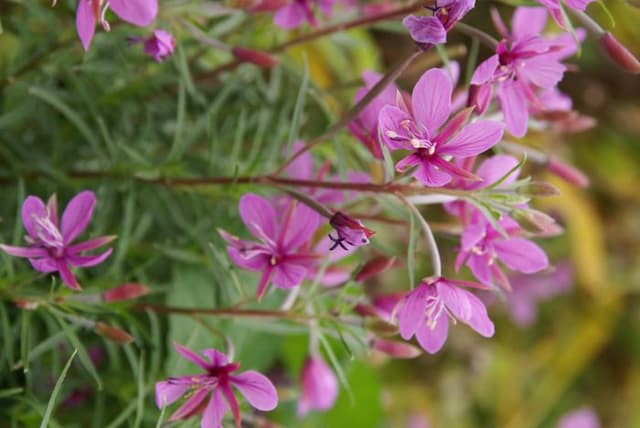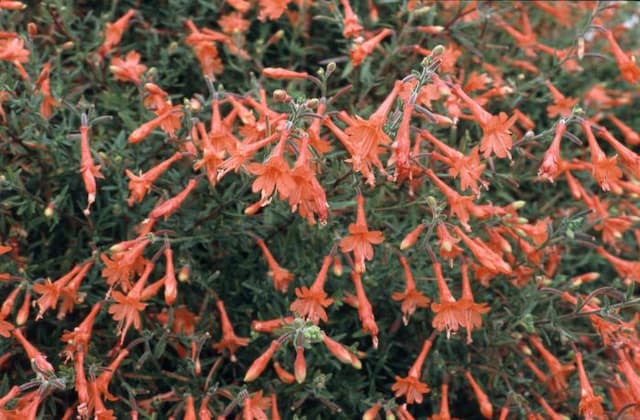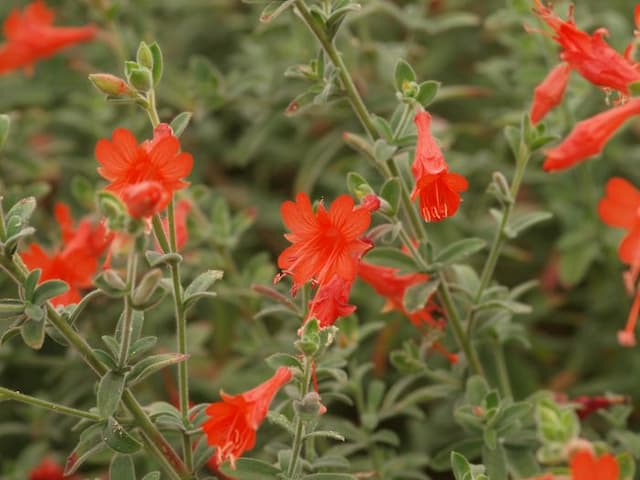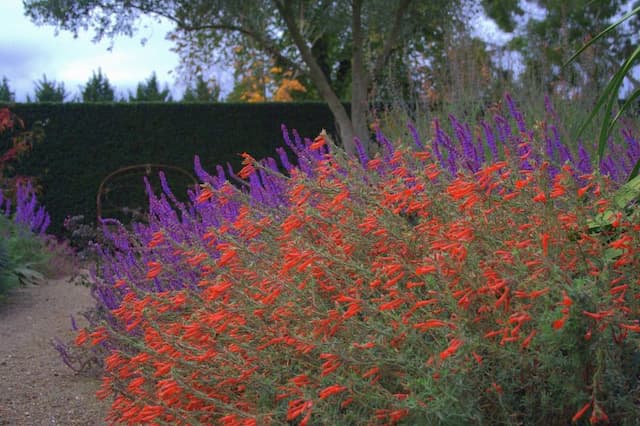Fuchsia Fuchsia 'Lena' (d)

ABOUT
The Fuchsia 'Lena' is a highly decorative plant known for its striking appearance. It stands out with its beautiful hanging flowers that are a combination of vibrant colors. Typical blooms display a graceful bell-like shape and are composed of a rich, deep purple corolla with delicate, petal-like structures that gracefully encircle the flower. Contrasting with the dark purple, the sepals that extend above the petals are a bright pink to light magenta hue, creating a stunning visual effect. The flowers of Fuchsia 'Lena' are not only notable for their colors but also for their elegant, long, and slightly curved teardrop shape. They dangle gracefully from the plant's branches, often in clusters, adding to the ornamental appeal of the plant. The foliage comprises small to medium-sized leaves which have a deep green color and a slight glossiness that complements the bright blooms. Fuchsia 'Lena' is a popular choice for hanging baskets and containers where its drooping flowers can be appreciated from below. When in full bloom, it provides a vivid display that instantly draws the eye, making it an excellent feature for decorative gardening and patios. The cascading nature of its flowers also makes it suitable for being grown in raised beds or on slopes where the flowers can spill over edges in a display of color and grace.
About this plant
 Names
NamesSynonyms
Lena Fuchsia, Lena Hardy Fuchsia, Lena Hummingbird Fuchsia.
Common names
Fuchsia 'Lena'
 Toxicity
ToxicityTo humans
Fuchsia plants, including the 'Lena' variety, are generally considered non-toxic to humans. While they are not poisonous, it is still not advisable to ingest the plant as it is not a food item, and doing so may cause mild gastrointestinal discomfort due to the plant's non-edible nature.
To pets
Fuchsia plants, such as the 'Lena' variety, are typically regarded as safe and non-toxic to pets, including cats and dogs. Ingestion of these plants is not expected to cause poisoning in pets. However, some animals might experience mild digestive upset if they consume large amounts of the plant material.
 Characteristics
CharacteristicsLife cycle
Perennials
Foliage type
Deciduous
Color of leaves
Green
Flower color
Mixed
Height
2 feet (60 cm)
Spread
2 feet (60 cm)
Plant type
Shrub
Hardiness zones
9
Native area
Central America
Benefits
 General Benefits
General Benefits- Ornamental Value: Fuchsia 'Lena' is popular for its decorative, pendulous flowers that add visual interest to gardens and landscapes.
- Attracts Wildlife: The tubular flowers of the Fuchsia are attractive to hummingbirds and butterflies, bringing pollinators to the garden.
- Versatility: It can be grown in containers, hanging baskets, or in the ground, making it adaptable to different gardening styles.
- Long Blooming Season: Fuchsias often have a prolonged flowering period from spring to fall, providing color for an extended time.
- Shade Tolerance: Fuchsias thrive in partial shade, making them ideal for brightening up darker areas of a garden.
- Easy Propagation: Cuttings from Fuchsia plants root easily, allowing gardeners to multiply their plants and share with others.
 Medical Properties
Medical PropertiesThis plant is not used for medical purposes.
 Air-purifying Qualities
Air-purifying QualitiesThis plant is not specifically known for air purifying qualities.
 Other Uses
Other Uses- Ink and Dye Production: Flowers from the Fuchsia can be used to create a natural dye or ink for fabric and paper, providing a soft purple or pink hue.
- Edible Decorations: The blooms of the Fuchsia are edible and can be used to embellish cakes, salads, and desserts, adding a splash of color and a unique flavor.
- Photography Subject: Due to its vivid flowers and interesting shape, Fuchsia can serve as a stunning subject for botanical photography and art.
- Craft Projects: The branches and flowers can be incorporated into craft projects, such as making wreaths or floral arrangements.
- Teaching Tool: Fuchsia can be used in educational settings to teach about plant biology, pollination, and the care of ornamental plants.
- Hummingbird Attractant: Planting Fuchsias in the garden can attract hummingbirds, providing natural entertainment and aiding in pollination.
- Landscape Design: Fuchsias can be used in landscape design to create colorful borders, hanging baskets, and window boxes.
- Eco-Friendly Confetti: Dried petals of the Fuchsia can be used as biodegradable confetti for celebrations, reducing environmental impact.
- Artistic Inspiration: The vibrant colors and forms of Fuchsias can inspire artists and designers in their work, influencing everything from fashion to interior design.
- Leaf Impressions: Fuchsia leaves can be used to make imprints or impressions in clay or cement for decorative stepping stones or pottery.
Interesting Facts
 Feng Shui
Feng ShuiThe plant Fuchsia is not used in Feng Shui practice.
 Zodiac Sign Compitability
Zodiac Sign CompitabilityThe plant Fuchsia is not used in astrology practice.
 Plant Symbolism
Plant Symbolism- Confiding Love: In the language of flowers, Fuchsia often represents confiding love, as they have a delicate, hanging bell-like appearance, evoking a sense of trust and intimacy.
- Elegance and Grace: With its elegant drooping flowers and graceful form, the fuchsia plant is often associated with sophistication and tasteful beauty.
- Ardent Affection: The vibrant colors and lush appearance of the fuchsia can symbolize a deep and passionate affection between individuals.
- Good Taste: Due to its ornate flowers and rich hues, fuchsia is sometimes associated with having good taste or appreciation for aesthetic beauty and refinement.
- Amiability: The fuchsia plant, with its friendly and inviting look, can represent amiability and a joyful, welcoming nature.
 Water
WaterFuchsia 'Lena', commonly known as hardy fuchsia, requires consistent moisture. During the growing season, water it thoroughly whenever the top inch of soil feels dry. On average, this might mean watering once or twice a week, depending on climate conditions, ensuring you're providing about one gallon of water per plant each time. During hot spells or windy weather, you may need to water more frequently to keep the soil from drying out. In winter, reduce watering but do not let the soil completely dry out.
 Light
LightHardy fuchsia flourishes in partial shade with some morning sun or dappled light throughout the day. An ideal spot is one where it's protected from the hot afternoon sun, which can scorch the delicate leaves. East or north-facing locations that receive bright but indirect light are typically the best.
 Temperature
TemperatureThe hardy fuchsia prefers cooler temperatures and thrives in a range between 55°F and 75°F. It can survive minimum temperatures of around 40°F but can be damaged or killed by temperatures below freezing. Protect the plant from extreme heat by providing shade during the hottest part of the day.
 Pruning
PruningPruning encourages a bushier growth habit and more flowers for hardy fuchsia. Prune in late winter or early spring before new growth begins by cutting back the previous year's growth by about a third to a half. Remove any dead or damaged wood at this time and thin out any overly crowded branches. Pruning can be done annually.
 Cleaning
CleaningAs needed
 Soil
SoilThe best soil mix for Fuchsia 'Lena' should be rich, well-draining, and contain peat moss, sand, and loam. The ideal pH for this plant is slightly acidic, around 6.0 to 7.0.
 Repotting
RepottingFuchsia 'Lena' should be repotted every 2-3 years, or when the roots have filled the pot and it becomes root-bound.
 Humidity & Misting
Humidity & MistingFuchsia 'Lena' thrives in high humidity conditions, ideally between 60-70%.
 Suitable locations
Suitable locationsIndoor
Bright indirect light, keep soil moist, high humidity.
Outdoor
Morning sun, afternoon shade, sheltered from strong winds.
Hardiness zone
10-11 USDA
 Life cycle
Life cycleFuchsia 'Lena', commonly known as hardy fuchsia or lady's eardrops, begins its life when seeds germinate, typically in warm and moist conditions in spring. The seedlings develop into young plants, showing off their characteristic green foliage. As the plant matures into its vegetative stage, it forms a bushy habit with numerous branches that bear oval-shaped leaves. During the flowering stage, usually in the late spring to summer, the plant produces pendulous, teardrop-shaped flowers with a unique combination of purple and red petals and long stamens. After pollination, often by hummingbirds or other pollinators, the flowers develop into small, dark-purple fruits. The plant may enter dormancy in the fall or winter, particularly in colder climates, dying back to the ground, only to regrow from its crown when favorable conditions return in spring.
 Propogation
PropogationPropogation time
Spring to Summer
The Fuchsia 'Lena', commonly referred to simply as hardy fuchsia, is often propagated through softwood cuttings during late spring or early summer when the plant is actively growing. This is the most popular method for multiplying this ornamental shrub. To propagate by cuttings, select a healthy, non-flowering shoot and cut a 3 to 5 inch (approximately 7.5 to 12.5 cm) piece, making sure it includes at least two sets of leaves. Remove the bottom leaves and dip the cut end into rooting hormone to encourage root growth. Then, insert the cutting into a pot filled with a mix of peat and perlite or a good quality potting soil. Keep the soil moist and place the pot in indirect light until roots have established, after which the new fuchsia can be transplanted outdoors or into a larger pot.









